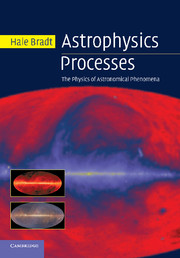Book contents
- Frontmatter
- Contents
- List of figures
- List of tables
- Preface
- Acknowledgments
- Also by the author
- 1 Kepler, Newton, and the mass function
- 2 Equilibrium in stars
- 3 Equations of state
- 4 Stellar structure and evolution
- 5 Thermal bremsstrahlung radiation
- 6 Blackbody radiation
- 7 Special theory of relativity in astronomy
- 8 Synchrotron radiation
- 9 Compton scattering
- 10 Hydrogen spin-flip radiation
- 11 Dispersion and Faraday rotation
- 12 Gravitational lensing
- Credits, further reading, and references
- Glossary
- Appendix: Units, symbols, and values
- Index
5 - Thermal bremsstrahlung radiation
Published online by Cambridge University Press: 05 June 2012
- Frontmatter
- Contents
- List of figures
- List of tables
- Preface
- Acknowledgments
- Also by the author
- 1 Kepler, Newton, and the mass function
- 2 Equilibrium in stars
- 3 Equations of state
- 4 Stellar structure and evolution
- 5 Thermal bremsstrahlung radiation
- 6 Blackbody radiation
- 7 Special theory of relativity in astronomy
- 8 Synchrotron radiation
- 9 Compton scattering
- 10 Hydrogen spin-flip radiation
- 11 Dispersion and Faraday rotation
- 12 Gravitational lensing
- Credits, further reading, and references
- Glossary
- Appendix: Units, symbols, and values
- Index
Summary
What we learn in this chapter
A hot plasma of ionized atoms emits thermal bremsstrahlung radiation through the Coulomb collisions of the electrons and ions. The electrons experience large accelerations in the collisions and thus efficiently radiate photons, which escape the plasma if it is optically thin. The energy Q radiated in a single collision is obtained from Larmor's formula. The characteristic frequency of the emitted radiation is estimated from the duration of the collision, which, in turn, depends on the electron speed and its impact parameter (projected distance of closest approach to the ion). Multiplication of Q by the electron flux and ion density and integration over the range of speeds in the Maxwell–Boltzmann distribution yield the volume emissivityjν(ν) (W m−3 Hz−1), the power emitted from unit volume into unit frequency interval at frequency ν as a function of frequency. It is proportional to the product of the electron and ion densities and is approximately exponential with frequency. A slowly varying Gaunt factor modifies the spectral shape somewhat. Most of the power is emitted at frequencies near that specified by hν ≈ kT.
Integration of the volume emissivity over all frequencies and over the volume of a plasma cloud results in the luminosity of the cloud. […]
- Type
- Chapter
- Information
- Astrophysics ProcessesThe Physics of Astronomical Phenomena, pp. 181 - 204Publisher: Cambridge University PressPrint publication year: 2008



